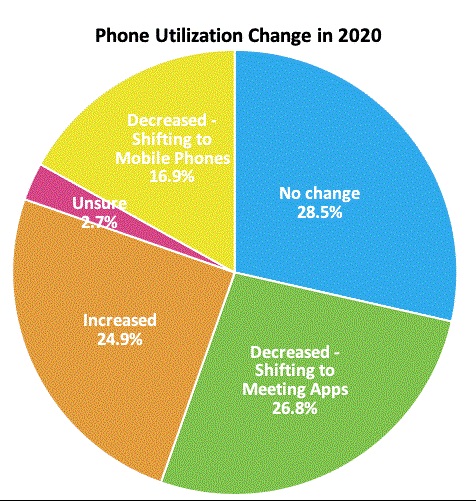The last year has seen an unprecedented rise in use of videoconferencing, not just for group meetings but also for 1:1 conversation. According to our recently released “
Workplace Collaboration 2021-22” global research study, Metrigy has found that 82% of participants now use video for all or most meetings, and that nearly 87% see video as a critical or important technology for business operations. For many, it is indeed true that video is the new voice!
It stands to reason that the rise of video has led to a reduction in reliance on enterprise phone systems for communications, and that’s true: Almost 44% say that phone utilization declined in 2020, by an average of 34.6%. But video is only partly to blame. While it’s true that 28.6% say that calls have shifted to video-enabled meeting apps, another 16.9% say that they are seeing calling shifting toward personal mobile phones.
For many of those working from home, a new communications paradigm has developed: Mobile phones for when a phone call is absolutely necessary, and meeting apps for everything else. Today, it’s as common for someone to message a co-worker to check availability to chat, and then launch a meeting from within a team space, as it is to dial a number or click on a name in a directory to place a call.
So do these trends portend a future in which enterprise phone systems disappear? No, this is not the case at all (and indeed 24.9% say that phone system utilization is growing). What it does mean is the following:
- Organizations need to evolve their management strategies – Today, many companies have invested in network, performance, and administration management tools for their phone systems. Those investments not only must continue to support phone systems, but also evolve to support meeting apps as well as any embedded audio and/or video delivered using CPaaS or APIs available from platform providers. Management strategies must also evolve to support a growing shift from on-premises, hosted, and hybrid calling models to the cloud. And, companies must ensure that employees still are able to reach a local E911 answering point, regardless of where they are working at any given point in time.
- PSTN access strategies need revisiting – This is especially true as organizations shift to UCaaS. With providers like Microsoft and Zoom offering the ability for continued use of existing SIP trunks, companies must look at a PSTN access strategy that offers flexibility as call volumes change, and that enables support for additional value-added features. Use of CPaaS, for example, enables optimized provisioning of calling and messaging features to any application.
- Overall call volumes may not change – While it’s true that phone system utilization is declining at many enterprises, overall call volumes often aren’t. The decline is offset by rising volume of inbound calls into contact centers to support an increasing number of remote employees and customer support needs. Around a third of our study participants are adding SIP trunks, while just under 7% are reducing them.
- Phone numbers and messaging must merge – Almost 64% of companies are either enabling SMS to and from their phone numbers, or are planning to do so by the end of 2021. It is no longer acceptable to have one phone number for calls, and another for messaging
- Plan for even more use of mobile devices – Desktop phones were in decline even before the pandemic, as PSTN calling increasingly shifted to PC or mobile apps and headsets. The growing use of mobile phones creates a challenge for organizations wishing to integrate calling into apps like customer relationship management with the goal of automatically tracking calls to and from prospects. Companies will need to consider investing in services that 1) enable mobile and desktop number unification, 2) provide for the ability for individuals to use their native dialers on their mobile devices, and 3) support business and personal personas.
Like most collaboration and communications platforms over the last year, the enterprise phone system is undergoing an accelerated rate of transformation. The future is likely to see even more reliance on meeting apps, coupled with a rapid convergence of mobile devices and enterprise telephony capabilities to provide seamless integration with back-office applications.











